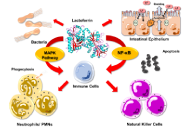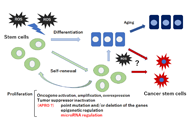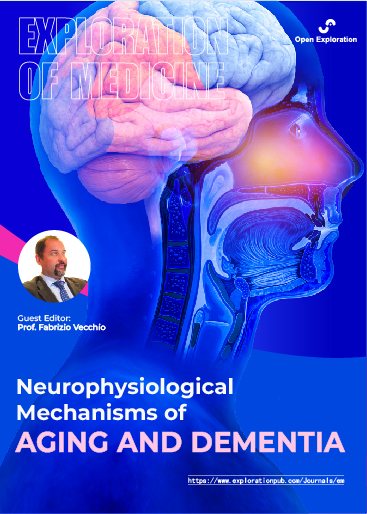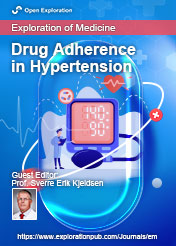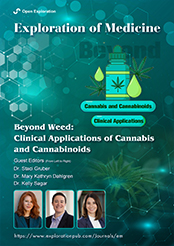-
Exploration of Medicine
eISSN: 2692-3106EiC: Lindsay A. Farrer, USAFrequency: Continuous PublicationAPC: $2,000 per article (See APC Waivers and Discounts)Publishing Model: Open AccessPeer Review Model: Single BlindIndexing & Archiving: Scopus, Google Scholar, DOAJ, CAS, Dimensions, Portico, etc. The journal is also the member of COPE.Articles Microbiota recruitment for brain cancer managementOpen AccessReviewThe interplay between the gut microbiota and the central nervous system is increasingly recognized as a critical factor in the pathogenesis and treatment responsiveness of brain tumors. The brain in [...] Read more.Ruty Mehrian-ShaiPublished: June 20, 2025 Explor Med. 2025;6:1001335
Microbiota recruitment for brain cancer managementOpen AccessReviewThe interplay between the gut microbiota and the central nervous system is increasingly recognized as a critical factor in the pathogenesis and treatment responsiveness of brain tumors. The brain in [...] Read more.Ruty Mehrian-ShaiPublished: June 20, 2025 Explor Med. 2025;6:1001335
DOI: https://doi.org/10.37349/emed.2025.1001335
This article belongs to the special issue Personalized Medicine in Cancer Therapy Liver and obesity: a narrative reviewOpen AccessReviewObesity is a multifactorial chronic disease characterized by an excess of adipose tissue, placing a growing burden on individual health and public health systems worldwide. Here we aim to elucidate [...] Read more.Amedeo Lonardo, Ralf WeiskirchenPublished: June 18, 2025 Explor Med. 2025;6:1001334
Liver and obesity: a narrative reviewOpen AccessReviewObesity is a multifactorial chronic disease characterized by an excess of adipose tissue, placing a growing burden on individual health and public health systems worldwide. Here we aim to elucidate [...] Read more.Amedeo Lonardo, Ralf WeiskirchenPublished: June 18, 2025 Explor Med. 2025;6:1001334
DOI: https://doi.org/10.37349/emed.2025.1001334 Ebola virus persistence: implications for human-to-human transmission and new outbreaksOpen AccessReviewEbola virus (EBOV) infection usually leads to highly lethal EBOV disease (EVD) with associated viraemia. Viraemia is cleared in those that do survive, however, EBOV may remain hidden in the testes a [...] Read more.Oliver Meek ... Miles W. CarrollPublished: June 18, 2025 Explor Med. 2025;6:1001333
Ebola virus persistence: implications for human-to-human transmission and new outbreaksOpen AccessReviewEbola virus (EBOV) infection usually leads to highly lethal EBOV disease (EVD) with associated viraemia. Viraemia is cleared in those that do survive, however, EBOV may remain hidden in the testes a [...] Read more.Oliver Meek ... Miles W. CarrollPublished: June 18, 2025 Explor Med. 2025;6:1001333
DOI: https://doi.org/10.37349/emed.2025.1001333
This article belongs to the special issue Emerging Infectious Diseases A prospective study of cognitive impairment in Parkinson’s disease: clinical, neuropsychological, and neuroimaging correlatesOpen AccessOriginal ArticleAim: Parkinson’s disease (PD) is a progressive neurodegenerative disorder marked by dopaminergic neuron loss, leading to motor and non-motor symptoms. Cognitive impairment in PD (PD-CI), rangin [...] Read more.Ahmed A. Gaballa ... Ahmed El-adawyPublished: June 18, 2025 Explor Med. 2025;6:1001332
A prospective study of cognitive impairment in Parkinson’s disease: clinical, neuropsychological, and neuroimaging correlatesOpen AccessOriginal ArticleAim: Parkinson’s disease (PD) is a progressive neurodegenerative disorder marked by dopaminergic neuron loss, leading to motor and non-motor symptoms. Cognitive impairment in PD (PD-CI), rangin [...] Read more.Ahmed A. Gaballa ... Ahmed El-adawyPublished: June 18, 2025 Explor Med. 2025;6:1001332
DOI: https://doi.org/10.37349/emed.2025.1001332
This article belongs to the special issue Neurophysiological Mechanisms of Aging and Dementia Analysis of COVID-19 prevalence in Belarus, Thailand, and Lithuania utilizing the SIR model during the COVID eraOpen AccessOriginal ArticleAim: Since its emergence in 2019, coronavirus disease 2019 (COVID-19) has evolved into a global pandemic, placing extraordinary strain on healthcare systems and societies worldwide. Accurate fore [...] Read more.Zahra Shirmohammadi ... Hossein RazghandiPublished: June 11, 2025 Explor Med. 2025;6:1001331
Analysis of COVID-19 prevalence in Belarus, Thailand, and Lithuania utilizing the SIR model during the COVID eraOpen AccessOriginal ArticleAim: Since its emergence in 2019, coronavirus disease 2019 (COVID-19) has evolved into a global pandemic, placing extraordinary strain on healthcare systems and societies worldwide. Accurate fore [...] Read more.Zahra Shirmohammadi ... Hossein RazghandiPublished: June 11, 2025 Explor Med. 2025;6:1001331
DOI: https://doi.org/10.37349/emed.2025.1001331 Inflammatory bowel diseases: what lactoferrin can do for us?Open AccessReviewLactoferrin (LF), an iron-binding protein, is found in mammalian milk. LF is also secreted by different cell phenotypes. LF shows a wide range of biological activities, as many preclinical and clini [...] Read more.Anne BlaisPublished: June 09, 2025 Explor Med. 2025;6:1001330
Inflammatory bowel diseases: what lactoferrin can do for us?Open AccessReviewLactoferrin (LF), an iron-binding protein, is found in mammalian milk. LF is also secreted by different cell phenotypes. LF shows a wide range of biological activities, as many preclinical and clini [...] Read more.Anne BlaisPublished: June 09, 2025 Explor Med. 2025;6:1001330
DOI: https://doi.org/10.37349/emed.2025.1001330
This article belongs to the special issue Gut Microbiota Derived Metabolites and Chronic Inflammatory DiseasesSpecial Issues Practical Tips for Cancer Care: Guidance for Patients, Caregivers, and Healthcare Professionals
Practical Tips for Cancer Care: Guidance for Patients, Caregivers, and Healthcare ProfessionalsProf. Patricia Tai
Submission Deadline: September 30, 2025
Published Articles: 0
 Assessment of Atrial and Ventricular Volumes and Functional Properties: Novel Insights
Assessment of Atrial and Ventricular Volumes and Functional Properties: Novel InsightsProf. Attila Nemes
Submission Deadline: August 31, 2025
Published Articles: 0
 Lipid Peroxidation and Cancer
Lipid Peroxidation and CancerProf. Neven Zarkovic
Submission Deadline: July 31, 2025
Published Articles: 0
 Innovative Approaches to Chronic Pain Management: from Multidisciplinary Strategies to Artificial Intelligence Perspectives
Innovative Approaches to Chronic Pain Management: from Multidisciplinary Strategies to Artificial Intelligence PerspectivesProf. Marco Cascella
Submission Deadline: August 31, 2025
Published Articles: 2
 Global Perspectives on the Clinical Diagnosis, Treatment, and Functional Cure of HIV Infection in the Post-ART Era
Global Perspectives on the Clinical Diagnosis, Treatment, and Functional Cure of HIV Infection in the Post-ART EraProf. Hongzhou Lu
Submission Deadline: July 31, 2025
Published Articles: 2
 Disrupted Cytokine Signaling Pathways in Autoimmunity
Disrupted Cytokine Signaling Pathways in AutoimmunityProf. Alister C. Ward
Submission Deadline: May 31, 2025
Published Articles: 0
 Molecular Diagnostics in Oncology
Molecular Diagnostics in OncologyProf. Evgeny Imyanitov
Submission Deadline: July 31, 2025
Published Articles: 3
 Advances in Oral Cancer: Prevention, Diagnosis, and Therapeutics
Advances in Oral Cancer: Prevention, Diagnosis, and TherapeuticsDr. Luca Fiorillo
Submission Deadline: July 31, 2025
Published Articles: 4
 Artificial Intelligence and Machine Learning in Cardiovascular Medicine
Artificial Intelligence and Machine Learning in Cardiovascular MedicineProf. Zhong Wang Dr. Ienglam Lei Dr. Liu Liu
Submission Deadline: August 31, 2025
Published Articles: 1
 Prostate Specific Membrane Antigen (PSMA) in Prostate Cancer
Prostate Specific Membrane Antigen (PSMA) in Prostate CancerDr. Finn Edler von Eyben
Submission Deadline: June 30, 2025
Published Articles: 0
 Neurophysiological Mechanisms of Aging and Dementia
Neurophysiological Mechanisms of Aging and DementiaProf. Fabrizio Vecchio
Submission Deadline: May 31, 2025
Published Articles: 5
 Personalized Medicine in Cancer Therapy
Personalized Medicine in Cancer TherapyProf. Haim Werner Prof. Ilan Bruchim
Submission Deadline: June 30, 2025
Published Articles: 1
 Spotlight on Cervical Cancer: Prevention, Early-Diagnosis, and Treatments
Spotlight on Cervical Cancer: Prevention, Early-Diagnosis, and TreatmentsDr. Andrea Giannini Dr. Giorgio Bogani
Submission Deadline: May 31, 2025
Published Articles: 4
 Drug Adherence in Hypertension
Drug Adherence in HypertensionProf. Sverre E. Kjeldsen
Submission Deadline: April 30, 2025
Published Articles: 6
 Emerging Infectious Diseases
Emerging Infectious DiseasesProf. Marcos Roberto Tovani-Palone
Submission Deadline: June 30, 2025
Published Articles: 5
 Gut Microbiota Derived Metabolites and Chronic Inflammatory Diseases
Gut Microbiota Derived Metabolites and Chronic Inflammatory DiseasesDr. Zeneng Wang
Submission Deadline: May 31, 2025
Published Articles: 5
 Lung Fibrosis—Models and Mechanisms
Lung Fibrosis—Models and MechanismsProf. Bernhard Ryffel
Submission Deadline: June 30, 2025
Published Articles: 4
-
-
Newsletter
-
Selected Special Issues
-
Articles Available in PMCPapers supported by NIH (or other funding bodies) are encouraged to be deposited in PMC.






